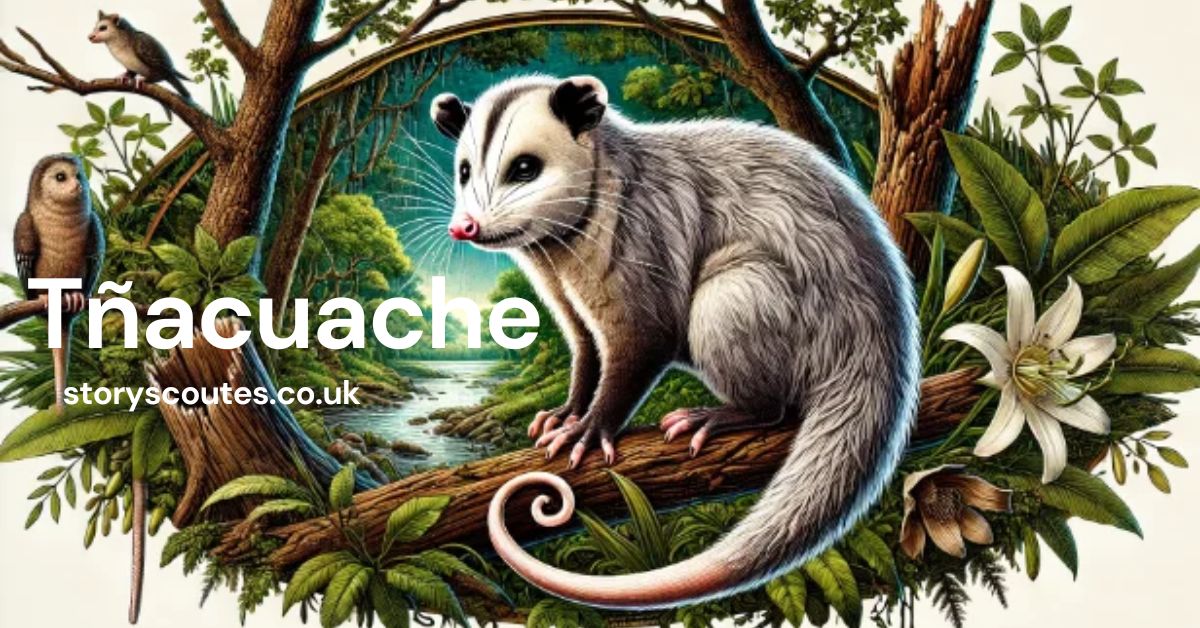Tñacuache: The Fascinating Opossum
When it comes to unique creatures, the tñacuache, commonly known as the opossum, stands out as a remarkable and intriguing animal. Native to the Americas, the opossum has captivated the curiosity of many with its distinct behaviors and characteristics. This article delves deep into the world of the tñacuache, exploring its biology, behavior, and significance, while also providing insights and interpretations that go beyond the basics. Whether you’re a nature enthusiast or simply curious about this fascinating creature, this comprehensive guide will provide you with everything you need to know about the tñacuache.
What Is a Tñacuache?
Understanding the Term “Tñacuache”
The term “tñacuache” is derived from the Nahuatl language, spoken by the Aztecs and still used by some indigenous groups in Mexico. In English, the tñacuache is commonly known as the opossum. The name “opossum” itself is derived from the Powhatan language, spoken by indigenous peoples in the southeastern United States.
Scientific Classification of the Tñacuache
The tñacuache belongs to the family Didelphidae, which is a group of marsupials. The scientific name for the Virginia opossum, one of the most well-known species, is Didelphis virginiana. This family is unique among mammals due to its marsupial reproductive system, which involves giving birth to relatively undeveloped young that continue to develop in the mother’s pouch.
Physical Characteristics of the Tñacuache
Size and Appearance
The tñacuache can vary in size depending on the species. On average, it measures about 16 to 20 inches in body length, with a tail that can add another 12 to 16 inches. The Virginia opossum, for instance, typically weighs between 4 to 14 pounds.
The appearance of the tñacuache is equally distinctive. It has a long, prehensile tail, which helps it grasp and manipulate objects. Its fur is generally a mix of gray and white, and it has a pointed snout with large, rounded ears. One of its most noticeable features is its sharp, white teeth, which it uses for defense and feeding.
Adaptations for Survival
The tñacuache has several unique adaptations that help it thrive in various environments. Its prehensile tail is a crucial adaptation, allowing it to navigate and forage in trees and other elevated areas. Additionally, the opossum’s ability to play dead, or “playing possum,” is a remarkable defense mechanism. When threatened, it can fall into a state of near-catatonia, mimicking death to deter predators.
Habitat and Distribution
Geographic Range
The tñacuache is native to the Americas, with its range extending from the southern United States to Central America and parts of South America. It is highly adaptable and can be found in a variety of habitats, including forests, grasslands, and urban areas. Its ability to live in diverse environments makes it a common sight in many regions.
Preferred Habitats
While the tñacuache is adaptable, it tends to favor habitats that provide ample food sources and shelter. Forests and woodlands are ideal due to the abundance of food and the availability of hiding spots. However, the tñacuache is also commonly found in urban areas, where it scavenges for food and takes advantage of the shelter provided by human structures.
Behavior and Diet
Daily and Seasonal Behavior
The tñacuache is primarily nocturnal, meaning it is most active during the night. It spends much of its time foraging for food, exploring its surroundings, and avoiding predators. During the day, it typically rests in dens or shelters, which can include tree hollows, burrows, and even discarded human items like boxes and tires.
In terms of seasonal behavior, the tñacuache does not hibernate. It remains active year-round, adjusting its behavior and diet according to seasonal changes. For example, it may forage more extensively in the fall to build up fat reserves for the winter months.
Diet and Feeding Habits
The tñacuache is an omnivore, meaning it has a varied diet that includes both plant and animal matter. Its diet consists of fruits, vegetables, insects, small rodents, and carrion. This diverse diet allows it to adapt to different environments and food availability. The opossum’s scavenging behavior also makes it an important part of the ecosystem, helping to clean up dead animals and reduce the spread of disease.
Reproduction and Life Cycle
Breeding and Mating
The tñacuache’s reproductive cycle is fascinating and differs from that of many other mammals due to its marsupial nature. Breeding typically occurs once a year, with the mating season varying by region. After mating, the female tñacuache gives birth to a large number of tiny, undeveloped young. These young, called joeys, then climb into the mother’s pouch to continue their development.
Development of Young
Inside the pouch, the joeys remain attached to their mother’s teats, where they receive nourishment and continue to develop. After about two to three months, they begin to venture out of the pouch but continue to nurse from their mother. As they grow, they start to explore their surroundings and learn essential survival skills. By the time they are six to eight months old, they are typically weaned and able to fend for themselves.
Lifespan and Longevity
In the wild, the tñacuache has a relatively short lifespan, averaging around 2 to 4 years. In captivity, however, it can live up to 7 years or more due to the absence of predators and access to consistent food sources. Despite its short lifespan, the tñacuache plays a crucial role in its ecosystem and has adapted well to its various habitats.
The Tñacuache in Culture and Folklore
Indigenous and Local Beliefs
In various indigenous cultures, the tñacuache holds significant cultural and symbolic meaning. For example, in some Native American traditions, the opossum is associated with cunning and adaptability. Its ability to play dead is often seen as a clever survival strategy and is incorporated into folklore and storytelling.
Popular Culture
The tñacuache has also made its way into popular culture, often portrayed in cartoons and media. Its unique appearance and behavior make it an interesting subject for stories and characters. In some cultures, the tñacuache is featured in children’s books and educational materials, helping to raise awareness and appreciation for this fascinating creature.
Conservation Status and Threats
Current Conservation Status
The tñacuache, particularly the Virginia opossum, is currently classified as a species of “Least Concern” by the International Union for Conservation of Nature (IUCN). This classification indicates that the species is not currently facing significant threats that would jeopardize its population on a large scale.
Threats and Challenges
Despite its stable conservation status, the tñacuache faces several challenges. Habitat loss due to urbanization and deforestation can impact its ability to find suitable shelter and food. Additionally, road accidents pose a significant threat, as opossums are often hit by vehicles while crossing roads in search of food.
Conservation Efforts
Conservation efforts for the tñacuache primarily focus on habitat preservation and reducing road mortality. Educating the public about the importance of these creatures and promoting wildlife-friendly practices can help mitigate some of the challenges they face. Organizations and wildlife groups are working to protect natural habitats and raise awareness about the tñacuache’s role in the ecosystem.
FAQs About the Tñacuache
What is a tñacuache?
The tñacuache, also known as the opossum, is a marsupial native to the Americas. It is known for its unique behaviors, such as playing dead, and its adaptability to various environments.
How does the tñacuache use its tail?
The tñacuache has a prehensile tail that it uses for grasping objects and navigating through trees. This adaptation helps it climb and balance in its natural habitat.
What does a tñacuache eat?
The tñacuache is an omnivore with a varied diet that includes fruits, vegetables, insects, small animals, and carrion. Its diverse diet allows it to thrive in different environments.
How long does a tñacuache live?
In the wild, the tñacuache typically lives for 2 to 4 years. In captivity, it can live up to 7 years or more due to the absence of predators and consistent food sources.
Why does the tñacuache play dead?
Playing dead
Why does the tñacuache play dead?
The tñacuache plays dead, or “playing possum,” as a defense mechanism to avoid predators. When threatened, it goes into a state of near-catatonia, mimicking death to deter attackers. This behavior helps the tñacuache avoid confrontation with predators that might otherwise attack.
What are some threats to the tñacuache?
The tñacuache faces threats such as habitat loss due to urbanization and deforestation. Additionally, road accidents are a significant risk as opossums often cross roads in search of food. Despite these challenges, the tñacuache is currently classified as a species of “Least Concern” by the IUCN.
How can people help protect the tñacuache?
People can help protect the tñacuache by supporting habitat conservation efforts, promoting wildlife-friendly practices, and raising awareness about the species. Avoiding littering and driving cautiously to reduce road mortality can also contribute to their protection.
Conclusion
The tñacuache, or opossum, is a fascinating and adaptable marsupial with unique characteristics that make it an intriguing subject of study. From its distinctive appearance and behaviors to its role in various ecosystems, the tñacuache offers valuable insights into the diversity of life on our planet. By understanding and appreciating this remarkable creature, we can contribute to its conservation and ensure that future generations continue to marvel at the wonders of the tñacuache.
As you explore the world of the tñacuache, remember its significance not just as a unique animal, but as an integral part of the natural world. By learning more about the tñacuache and supporting conservation efforts, we can help preserve this remarkable species for years to come.






